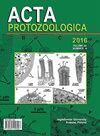New microsporidia, Glugea sardinellensis n sp (Microsporea, Glugeida) found in Sardinella aurita Valenciennes, 1847, collected off Tunisian coasts
IF 1.2
4区 生物学
Q4 MICROBIOLOGY
引用次数: 4
Abstract
A new microsporidia Glugea sardinellensis n. sp. found in the teleost fish Sardinella aurita Valenciennes collected from the Tunisian coasts. The parasite develops in a large xenomas measuring 1–16 mm in diameter and is generally visible with naked eye in the connective tissue around the pyloric caeca of the host. Xenoma were often rounded, but would be occasionally ovoid or irregular shape, generally creamy but rarely opaque, and filled with mature spores. The spores were unikaryotic pyriform measuring 5–5.5 (5.25±0.24) µm in length and 2.5–3 (2.75±0.24) µm in width. The posterior vacuole was large and occupied more than half of the spore. Ultrastructural study indicated that the mature spore has 13–14 coils of polar filament arranged in one layer, and a rough exospore. Intermediate stages were rare and randomly distributed in the xenoma. Merogonial and sporogonial stages were uni or binucleate. The plasma membrane surrounding the meront was irregular and indented. The mean prevalence was 18.3% and it varied according to season and locality. The distribution of prevalence according to fish size indicated that small fish were primarily affected. Phylogenetic analysis using the partial sequence of the SSU rDNA showed consistent association with species of the genus Glugea. The most closely related species was Glugea atherinae Berrebi, 1979 with 98.5% similarity.新小孢子虫,Glugea sardinellensis n sp(小孢子虫,Glugeida)于1847年在突尼斯海岸采集的valciennes aurita Sardinella发现
在突尼斯海岸采集的硬骨鱼沙丁鱼中发现一种新的Glugea sardinellensis n. sp。寄生虫生长在直径1 - 16mm的大异种瘤中,通常在宿主幽门盲肠周围的结缔组织中肉眼可见。异种瘤通常为圆形,但偶尔为卵圆形或不规则形状,通常为奶油状,但很少不透明,充满成熟孢子。孢子为单核梨形,长5 ~ 5.5(5.25±0.24)µm,宽2.5 ~ 3(2.75±0.24)µm。后空泡较大,占孢子的一半以上。超微结构研究表明,成熟孢子有13 ~ 14圈极丝排列成一层,外孢子粗糙。中间阶段在异种瘤中罕见且随机分布。分生期和孢子期为单核或双核。围绕meront的质膜不规则,呈凹陷状。平均患病率为18.3%,因季节和地区不同而有差异。根据鱼类大小的流行度分布表明,小鱼主要受影响。利用SSU rDNA的部分序列进行系统发育分析,表明其与Glugea属的种有一致的关联。最近的亲缘种是Glugea atherinae Berrebi, 1979,相似度为98.5%。
本文章由计算机程序翻译,如有差异,请以英文原文为准。
求助全文
约1分钟内获得全文
求助全文
来源期刊

Acta Protozoologica
生物-微生物学
CiteScore
2.00
自引率
0.00%
发文量
8
审稿时长
>12 weeks
期刊介绍:
Acta Protozoologica - International Journal on Protistology - is a quarterly journal that publishes current and comprehensive, experimental, and theoretical contributions across the breadth of protistology, and cell biology of Eukaryote microorganisms including: behaviour, biochemistry and molecular biology, development, ecology, genetics, parasitology, physiology, photobiology, systematics and phylogeny, and ultrastructure. It publishes original research reports, critical reviews of current research written by invited experts in the field, short communications, book reviews, and letters to the Editor.
 求助内容:
求助内容: 应助结果提醒方式:
应助结果提醒方式:


